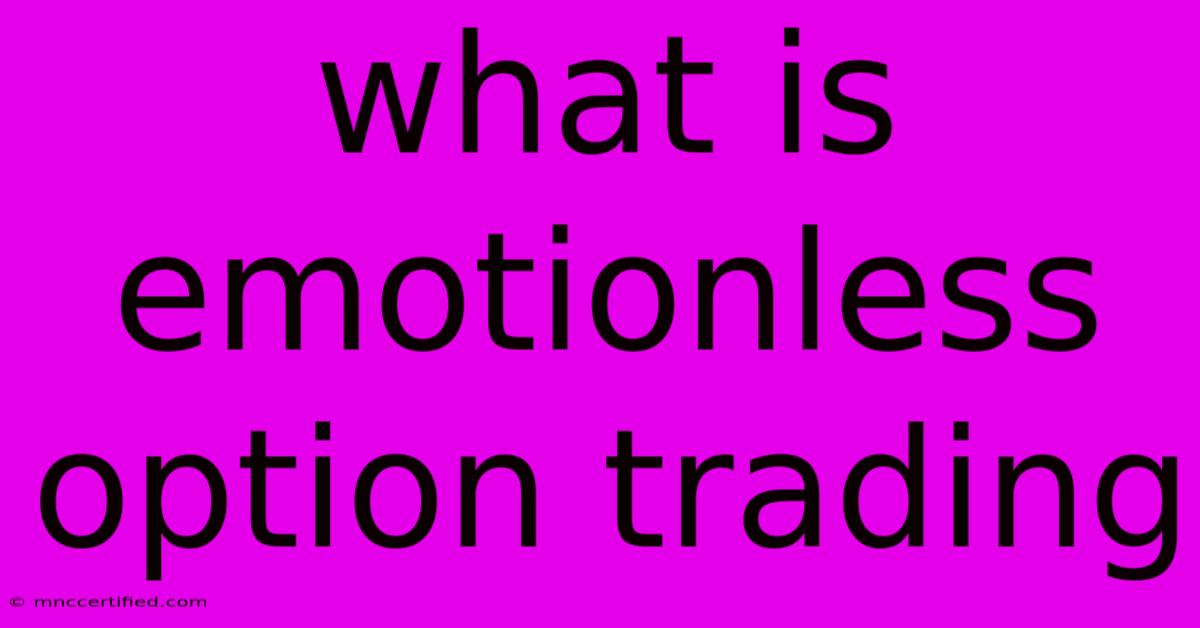What Is Emotionless Option Trading

Table of Contents
What is Emotionless Option Trading? Mastering the Art of Impartial Investing
Option trading, while potentially lucrative, is a notoriously volatile arena. Success hinges not just on understanding complex strategies, but also on mastering your emotional responses. This is where the concept of emotionless option trading comes into play. It's about removing the influence of fear, greed, and hope – the emotional triad that often leads to poor decision-making and significant losses.
Understanding the Emotional Traps of Option Trading
Before diving into how to achieve emotionless trading, let's first identify the emotional pitfalls that frequently derail even experienced traders:
- Fear of Loss (FOMO): This drives impulsive trades to "get in" before missing out, often at inflated prices. It also leads to holding losing positions longer than necessary, hoping for a reversal.
- Greed: The desire for quick, large profits fuels over-leveraging and risky trades, leading to potentially devastating losses if the market moves against you.
- Hope: The clinging to a losing trade, hoping for a miracle recovery, often results in further losses as the trader ignores rational exit strategies.
- Confirmation Bias: This is the tendency to seek out information that confirms pre-existing beliefs, while ignoring contradictory evidence. In option trading, it can lead to ignoring negative market signals and doubling down on bad decisions.
- Overconfidence: A string of successful trades can breed overconfidence, leading to riskier trades and a disregard for proper risk management.
The Pillars of Emotionless Option Trading
Emotionless option trading isn't about becoming a robot; it's about developing a disciplined and methodical approach that minimizes the impact of emotions. Here are the key pillars:
1. Develop a Robust Trading Plan
A well-defined trading plan acts as a roadmap, guiding your decisions and keeping you on track. It should include:
- Specific Entry and Exit Strategies: Define clear criteria for entering and exiting trades, based on technical analysis and market conditions, not gut feelings.
- Risk Management Rules: Establish position sizing, stop-loss orders, and maximum risk per trade to limit potential losses. Never risk more than you can afford to lose.
- Trade Journal: Maintain a detailed record of every trade, including rationale, entry/exit points, and the outcome. This helps identify patterns in your trading and areas for improvement.
2. Embrace Technical Analysis and Data-Driven Decisions
Instead of relying on intuition or market sentiment, base your decisions on objective technical analysis and fundamental data. Utilize charts, indicators, and other tools to identify trading opportunities and assess risk. Focus on facts, not feelings.
3. Practice Discipline and Patience
Option trading demands patience and discipline. Don't chase quick wins; stick to your trading plan and wait for the right opportunities. Avoid impulsive trades based on fear or greed. Discipline is key to long-term success.
4. Regularly Review and Adapt Your Strategy
Markets are dynamic; what works today might not work tomorrow. Regularly review your trading performance, identify weaknesses, and adapt your strategy as needed. Continuous learning and improvement are crucial.
5. Manage Stress and Maintain Mental Well-being
Trading can be stressful; managing stress levels is critical. Consider incorporating mindfulness techniques, exercise, and adequate sleep into your routine. A healthy mind makes for better trading decisions.
Conclusion: The Path to Profitable, Emotionless Option Trading
Becoming an emotionless option trader is a journey, not a destination. It requires consistent effort, self-awareness, and a commitment to continuous learning. By developing a robust trading plan, relying on data-driven decisions, practicing discipline, and managing stress, you can significantly improve your chances of long-term success in this challenging yet rewarding market. Remember, consistent profitability in options trading is built on a foundation of discipline and emotional control.

Thank you for visiting our website wich cover about What Is Emotionless Option Trading. We hope the information provided has been useful to you. Feel free to contact us if you have any questions or need further assistance. See you next time and dont miss to bookmark.
Featured Posts
-
Sunday Matinee Bulls At Utrgv
Nov 17, 2024
-
Nebraskas Simplified Offense Improves
Nov 17, 2024
-
Colorado Vs Utah Final Score Buffaloes Win
Nov 17, 2024
-
Moonflower Murders Cast Announced
Nov 17, 2024
-
Mercer Vs Alabama Game Live Updates
Nov 17, 2024